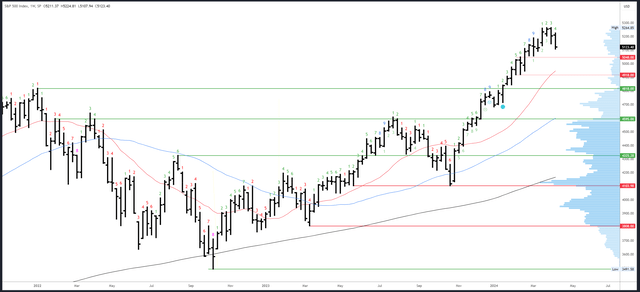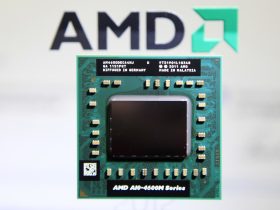It’s been two weeks since my last article, and there have been some significant developments. On the macro side, “higher for longer” rate expectations are back and the first cut is now expected in September rather than June or July. On the technical side, the S&P 500 (SPY) has finally broken its trend channel and settled below its 20dma. This signals the trend starting at the January low is likely over and a new phase has started.
However, this does not mean the S&P500 has topped. Every major trend is made up of smaller trends and corrective phases. As one trend sequence ends and corrects, it sets up another. This repeats until the major trend in the higher timeframes completes and either tops, or sets up a major correction and another major trend. This may sound complicated – and it is when you consider the current major trend originated in 2009, or taking it a step further, 1932 – but we can continue to look for inflection points and technical signals in order to simplify things.
This weekend’s article will take a simple look at whether the current correction is a buying opportunity, or a sell, and outline optimal locations to enter trades. Various techniques will be applied to multiple timeframes in a top-down process which also considers the major market drivers. The aim is to provide an actionable guide with directional bias, important levels, and expectations for future price action.
S&P 500 Monthly
The higher timeframe charts still have a bullish bias and it is unlikely the top is in.
Firstly, the Q1 and March bars closed right at the highs and there has been no clear signs of rejection; rather, the April bar faded from inside the March range leaving a “weak” high.
Secondly, when January, February and March all close higher like they have this year, the rest of the year has closed higher 19 out of 20 times.
All that said, there is plenty scope for a correction first. I distinctly remember pointing out the July ’23 monthly high was weak, and fully expected it to be exceeded. However, it took until December to finally break to new highs.
In short, the monthly chart suggests a decline will be a buy for 5300 at some point. Exactly when and where is best figured out on the lower timeframes.

SPX Monthly (TradingView)
The 5264.85 high is the only resistance.
Support at the February high of 5111 was tested on Friday and held into the weekly close. The March low of 5056 is the next level. Below there, the next support is all the way down at 4853.
April will be bar 5 (of a possible 9) in an upside Demark exhaustion count.
S&P 500 Weekly
Bigger picture, the weekly chart again supports the view that a weak high has been made. A strong high is created when prices are swiftly rejected and very little volume trades. On the contrary, the 5261-64 region was tested for three weeks in a row and plenty volume was traded around the highs.
Nearer term, this week’s bar closed very near the low for only the second time since the rally started in October ’23. This suggests the move should follow through to the downside.

SPX Weekly (TradingView)
Resistance is at 5224 and 5264.85.
The gap at 5117 has been filled and may lead to a bounce. However, 5048-5056 is a more important area and likely tested this month. A break of this zone would likely signal 4818 will be tested at some point.
The upside Demark exhaustion signal looks to be having an effect with a similar delay to the July ’23 signal. A new upside count is underway and will on bar 5 next week, but looks unlikely to continue to completion as next week’s bar would need to close above 5234.
S&P 500 Daily
Two clear channels can be tracked on the daily chart from the October ’23 low – the first peaked in December after an aggressive ramp higher. A small correction then set up the next uptrend and the channel which formed in Q1. This had a different character and less bullish action.
As mentioned in the introduction, both the channel and the 20dma have now been broken convincingly and held as resistance during last week’s bounce, indicating a new correctional phase. The big question now is whether this will be another small correction to set up yet another trend sequence higher, or if this decline will be a in a larger degree and drop to 4818 (at a minimum). 5048-5056 is where this question will be answered.

SPX Daily (TradingView)
Minor resistance is at 5138-46. Closing above this would likely lead to the 20dma and gap fill at 5199, with 5256 the next resistance above that.
Support is at Friday’s low of 5107 which came right on the 50dma and is in confluence with the 5111 February high and gap fill. This area may take a few attempts to break. The importance of 5048-5056 is underlined by the volume profile to the right of the chart – this is an area where prices have been rejected and very little volume has traded. 5042 is also the 38% Fib retrace of the Q1 rally and a “normal” retrace for a correction in this phase.
A downside Demark exhaustion signal will be on bar 3 on Monday and cannot complete next week.
Drivers/Events
CPI came in at 0.4% for the third month in a row. While hot NFP figures may not get the Fed to budge, inflation data certainly could. The market now expects a first cut in September, but has it over-reacted? Fed members are busy with speeches most days next week so keep a close eye on their message.
Retail Sales and the Empire State Manufacturing Index are due out on Monday in a much quieter week for data. Earnings season hots up with banks reporting and Netflix (NFLX) on Thursday after the bell.
Geopolitics is flaring up again in the Middle East amid warnings of an attack by Iran on Israel. Markets may have shrugged this off quickly while the uptrend persisted, but during this new phase there could be a more pronounced reaction.
Probable Moves Next Week(s)
Bigger picture, the higher timeframes have a weak high and a move above 5264.85 is still probable this year.
That said, the near-term path is likely lower and 5048-5056 could be tested in Q2. This area is an inflection for a much larger drop to 4818 and a re-test of the break-out point.
Next week likely sees a battle ranging between the 50dma and 5100 area to the downside, and the 20dma and gap fill at 5199 to the upside. This likely resolves lower for a drop to 5048-5056.
While I think 4818 will be reached, I would still buy 5048-5056 if there is a solid set up in the area. There may be a 50 point bounce, there may be a move straight to new highs, or there may be no bounce at all; I can’t predict what will happen, but I can prepare trades where the odds are favorable and the risk/reward is attractive.
Read the full article here









Leave a Reply